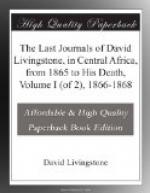25th October, 1866.—Came along northwards to Chimuna’s town, a large one of Chipeta with many villages around. Our path led through the forest, and as we emerged into the open strath in which the villages lie, we saw the large anthills, each the size of the end of a one-storied cottage, covered with men on guard watching for the Mazitu.
A long line of villagers were just arriving from the south, and we could see at some low hills in that direction the smoke arising from the burning settlements. None but men were present, the women and the chief were at the mountain called Pambe; all were fully armed with their long bows, some flat in the bow, others round, and it was common to have the quiver on the back, and a bunch of feathers stuck in the hair like those in our Lancers’ shakos. But they remained not to fight, but to watch their homes and stores of grain from robbers amongst their own people in case no Mazitu came! They gave a good hut, and sent off at once to let the chief at Pambe know of our arrival. We heard the cocks crowing up there in the mountain as we passed in the morning. Chimuna came in the evening, and begged me to remain a day in his village, Pamaloa, as he was the greatest chief the Chipeta had. I told him all wished the same thing, and if I listened to each chief we should never get on, and the rains were near, but we had to stay over with him.
26th October, 1866.—All the people came down to-day from Pambe, and crowded to see the strangers. They know very little beyond their own affairs, though these require a good deal of knowledge, and we should be sorely put about if, without their skill, we had to maintain an existence here. Their furnaces are rather bottle shaped, and about seven feet high by three broad. One toothless patriarch had heard of books and umbrellas, but had never seen either. The oldest inhabitant had never travelled far from the spot in which he was born, yet he has a good knowledge of soils and agriculture, hut-building, basket-making, pottery, and the manufacture of bark-cloth and skins for clothing, as also making of nets, traps, and cordage.
Chimuna had a most ungainly countenance, yet did well enough: he was very thankful for a blister on his loins to ease rheumatic pains, and presented a huge basket of porridge before starting, with a fowl, and asked me to fire a gun that the Mazitu might hear and know that armed men were here. They all say that these marauders flee from fire-arms, so I think that they are not Zulus at all, though adopting some of their ways.
In going on to Mapuio’s we passed several large villages, each surrounded by the usual euphorbia hedge, and having large trees for shade. We are on & level, or rather gently amdulating country, rather bare of trees. At the junctions of these earthen waves we have always an oozing bog, this often occurs in the slope down the trough of this terrestrial sea; bushes are common, and of the kind which were cut down as trees. Yellow haematite is very abundant, but the other rocks scarcely appear in the distance; we have mountains both on the east and west.




